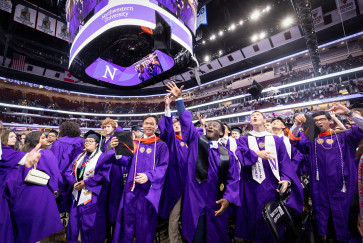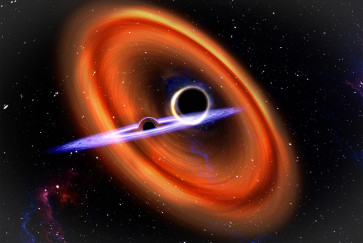Most people have heard of “love at first sight.” But how about “love at first collision?”
In a study fit for Valentine’s Day, Northwestern University astrophysicists discovered that binary black holes — when formed in crowded clusters of stars — align their spins before merging together.
As the black holes orbit one another, each object has its own spin. Previous research indicated these spins should be chaotic and random. However, in a study accepted for publication by The Astrophysical Journal Letters, the Northwestern scientists found binary black holes tend to spin in the same general direction as the pair’s overall orbital motion.
The reason for this behavior? It’s written in the stars.
Eating up, then syncing up
According to new simulations, as black holes glide across the cosmic dance floor, they collide into massive stars. After ripping the star apart, the black holes gobble up the stellar debris and become more massive.
This extra mass increases the black holes’ gravitational pull, which ultimately realigns their spins into the same direction as their orbital dance. As the binary black holes swirl toward one another in the visualization, their debris tails spin into celestial harmony, marked with the shape of a googly-eyed heart.
“When a massive star is torn apart by a binary black hole, it creates two separate streams of debris, each spiraling around one of the black holes,” said Northwestern’s Fulya Kıroğlu, who led the study. “Initially, the direction of these spinning debris clouds is random. However, as the black holes get closer, powerful tidal forces begin to realign these clouds, gradually influencing the spin direction of the black holes themselves. Over time, this process leads to black hole mergers with a slight but consistent alignment of their spins — something that had been seen in gravitational wave signals from merging binary black holes detected by LIGO/Virgo but had not been fully understood until now. This discovery challenges the common belief that black holes formed in star clusters always have randomly distributed spins.”
The researchers
Kıroğlu is a graduate student in physics and astronomy at Northwestern’s Weinberg College of Arts and Sciences, where she is advised by Professor Fred Rasio, the Joseph Cummings Professor of Physics. Kıroğlu and Rasio are members of the Center for Interdisciplinary Exploration and Research in Astrophysics (CIERA). The work also involves collaborators at Allegheny College and University of California, San Diego.

